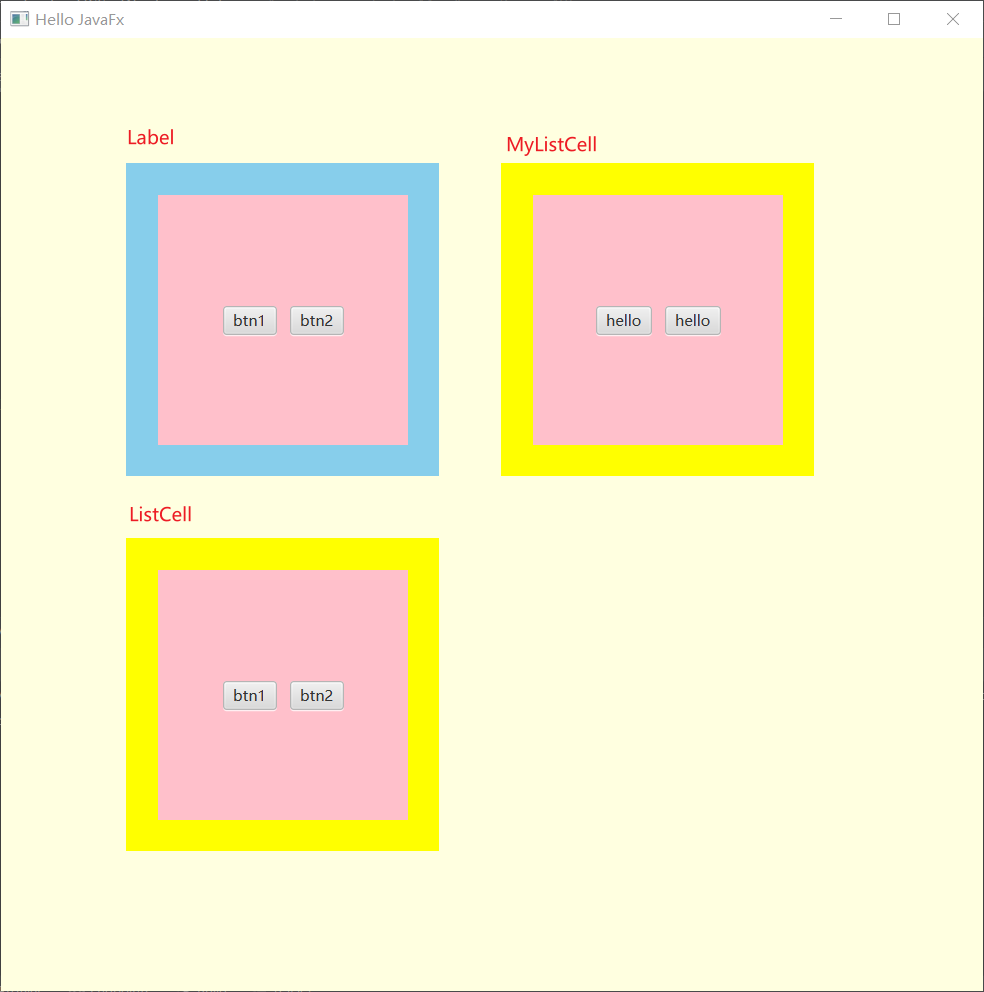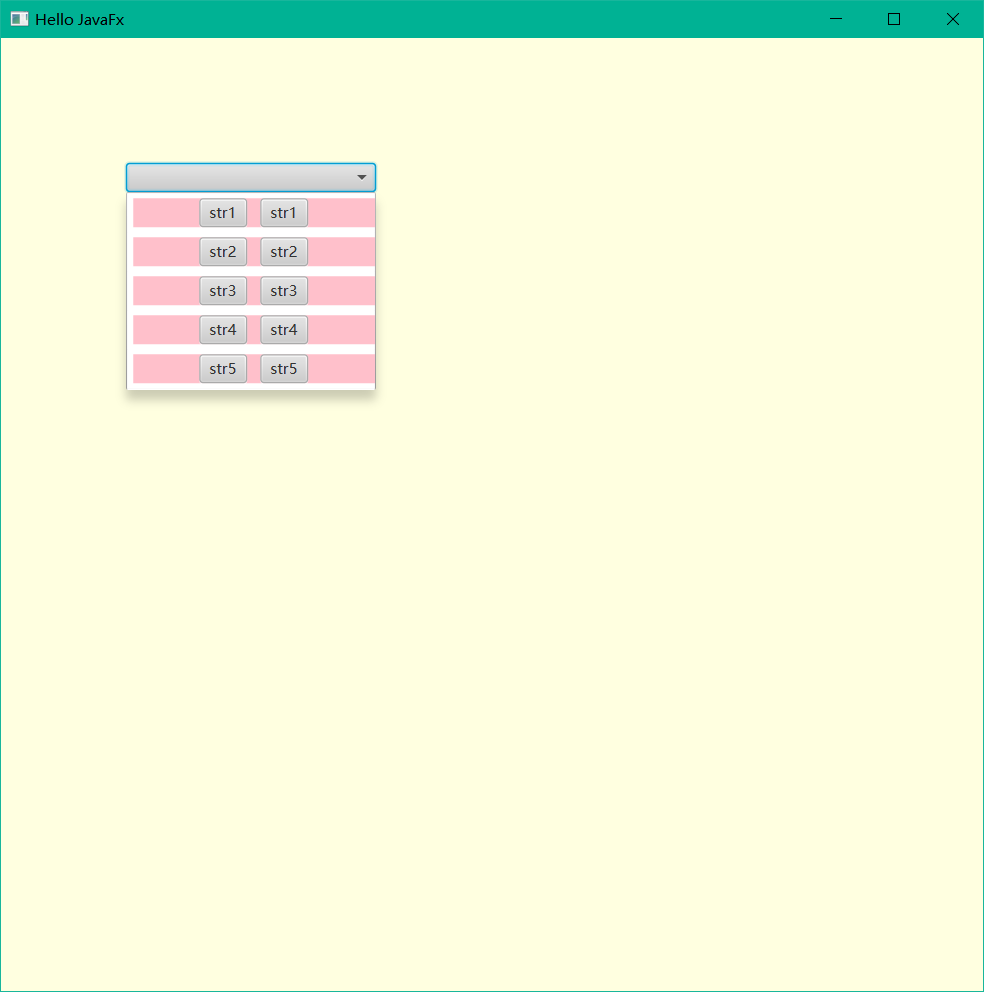使用setCellFactory自定义单元格(本节使用JDK9)
Label和ListCell
创建Label
Label label = new Label(); HBox hBox1 = new HBox(10); hBox1.setStyle("-fx-background-color: pink;"); hBox1.setAlignment(Pos.CENTER); hBox1.setMaxWidth(200); hBox1.setMaxHeight(200); hBox1.getChildren().addAll(new Button("btn1"), new Button("btn2")); label.setStyle("-fx-background-color: skyblue;"); label.setPrefWidth(250); label.setPrefHeight(250); label.setAlignment(Pos.CENTER); label.setContentDisplay(ContentDisplay.CENTER); // 此方法可以传入一个Node类型的变量 label.setGraphic(hBox1);创建ListCell
ListCell<String> listCell = new ListCell<>(); // 下面一行代码让ListCell在JDK8环境下不报NullPointerException // listCell.updateListView(new ListView<>()); listCell.setStyle("-fx-background-color: yellow;"); listCell.setPrefWidth(250); listCell.setPrefHeight(250); listCell.setAlignment(Pos.CENTER); listCell.setContentDisplay(ContentDisplay.CENTER); HBox hBox2 = new HBox(10); hBox2.setStyle("-fx-background-color: pink;"); hBox2.setAlignment(Pos.CENTER); hBox2.setMaxWidth(200); hBox2.setMaxHeight(200); hBox2.getChildren().addAll(new Button("btn1"), new Button("btn2")); listCell.setGraphic(hBox2);创建自定义的ListCell
自定义ListCell类
class MyListCell<T> extends ListCell<T> { @Override protected void updateItem(T item, boolean empty) { super.updateItem(item, empty); HBox hBox2 = new HBox(10); hBox2.setStyle("-fx-background-color: pink;"); hBox2.setAlignment(Pos.CENTER); hBox2.setMaxWidth(200); hBox2.setMaxHeight(200); hBox2.getChildren().addAll(new Button(item.toString()), new Button(item.toString())); this.setStyle("-fx-background-color: yellow;"); this.setPrefWidth(250); this.setPrefHeight(250); this.setAlignment(Pos.CENTER); this.setContentDisplay(ContentDisplay.CENTER); this.setGraphic(hBox2); } }创建MyListCell
MyListCell1<String> myListCell = new MyListCell1<>(); myListCell.updateItem("hello", true);
添加控件到布局中,调整位置,添加布局到场景,添加场景到舞台,调整舞台设置(省略)

泛型为String的ComboBox
创建下拉列表
ComboBox<String> comboBox = new ComboBox<>(); comboBox.getItems().addAll("str1", "str2", "str3", "str4", "str5"); comboBox.setPrefWidth(200);自定义ListCell类
class MyListCell<T> extends ListCell<T> { @Override protected void updateItem(T item, boolean empty) { super.updateItem(item, empty); if (!empty){ HBox hBox2 = new HBox(10); hBox2.setStyle("-fx-background-color: pink;"); hBox2.setAlignment(Pos.CENTER); hBox2.getChildren().addAll(new Button(item.toString()), new Button(item.toString())); this.setAlignment(Pos.CENTER); this.setContentDisplay(ContentDisplay.CENTER); this.setGraphic(hBox2); } } }设置自定义单元格
comboBox.setCellFactory(new Callback<ListView<String>, ListCell<String>>() { @Override public ListCell<String> call(ListView<String> param) { MyListCell<String> listCell = new MyListCell<>(); return listCell; } });添加控件到布局中,调整位置,添加布局到场景,添加场景到舞台,调整舞台设置(省略)

泛型为Student的ComboBox
创建5个Student对象
Student student1 = new Student("张三", 86, "语文"); Student student2 = new Student("李四", 94, "数学"); Student student3 = new Student("王五", 83, "英语"); Student student4 = new Student("赵六", 75, "物理"); Student student5 = new Student("钱七", 64, "化学");创建下拉列表
ComboBox<Student> comboBox = new ComboBox<>(); comboBox.getItems().addAll(student1, student2, student3, student4, student5); comboBox.setPrefWidth(200);自定义单元格
comboBox.setCellFactory(new Callback<>() { @Override public ListCell<Student> call(ListView<Student> param) { System.out.println(Color.BLUE + "call"); // 匿名内部类 ListCell<Student> listCell = new ListCell<>() { @Override protected void updateItem(Student item, boolean empty) { super.updateItem(item, empty); if (!empty) { HBox hBox = new HBox(10); ImageView imageView = new ImageView("/images/logo.png"); imageView.setFitWidth(20); imageView.setFitHeight(20); Label name = new Label(item.getName()); Label score = new Label(item.getScore() + ""); Label subject = new Label(item.getSubject()); hBox.getChildren().addAll(imageView, name, new Separator(), score, new Separator(), subject); setGraphic(hBox); } } }; return listCell; } });设置自定义字符串转换器
comboBox.setConverter(new StringConverter<>() { @Override public String toString(Student object) { System.out.println(Color.YELLOW + "toString"); if (object == null) { return ""; } String value = object.getName() + ":" + object.getScore() + ":" + object.getSubject(); return value; } // 在输入框中输入文本按下回车键时,调用此方法 @Override public Student fromString(String string) { return null; } });添加控件到布局中,调整位置,添加布局到场景,添加场景到舞台,调整舞台设置(省略)
